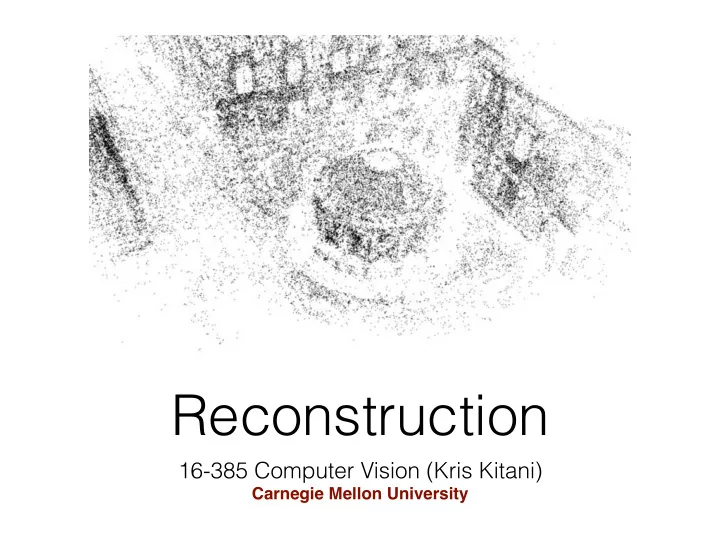

Reconstruction 16-385 Computer Vision (Kris Kitani) Carnegie Mellon University
Structure Motion Measurements (scene geometry) (camera geometry) 3D to 2D estimate Pose Estimation known correspondences 2D to 2D estimate Triangulation known coorespondences 2D to 2D estimate estimate Reconstruction coorespondences
Reconstruction (2 view structure from motion) Given a set of matched points { x i , x 0 i } Estimate the camera matrices P , P 0 Estimate the 3D point X
Reconstruction (2 view structure from motion) Given a set of matched points { x i , x 0 i } Estimate the camera matrices P , P 0 ‘motion’ (of the cameras) Estimate the 3D point X ‘structure’
Procedure for Reconstruction 1. Compute the Fundamental Matrix F from points correspondences 8-point algorithm x 0> m F x m = 0
Procedure for Reconstruction 1. Compute the Fundamental Matrix F from points correspondences 8-point algorithm 2. Compute the camera matrices P from the Fundamental matrix P = [ I | 0 ] and P’ = [ [ e ’ x ] F | e ’ ]
Camera matrices corresponding to the fundamental matrix F may be chosen as P 0 = [[ e ⇥ ] F | e 0 ] P = [ I | 0 ] (See Hartley and Zisserman C.9 for proof)
Decomposing F into R and T If we have calibrated cameras we have and K 0 K E = K 0> FK Essential matrix:
Decomposing F into R and T If we have calibrated cameras we have and K 0 K E = K 0> FK Essential matrix: 0 − 1 0 E = U Σ V > Let W = SVD: 1 0 0 0 0 1
Decomposing F into R and T If we have calibrated cameras we have and K 0 K E = K 0> FK Essential matrix: 0 − 1 0 E = U Σ V > Let W = SVD: 1 0 0 0 0 1 We get FOUR solutions: E = [ R | T ] R 2 = UW > V > T 1 = U 3 T 2 = − U 3 R 1 = UWV > two possible rotations two possible translations
We get FOUR solutions: R 1 = UWV > R 1 = UWV > T 1 = U 3 T 2 = − U 3 R 2 = UW > V > R 2 = UW > V > T 2 = − U 3 T 1 = U 3 Which one do we choose? Compute determinant of R, valid solution must be equal to 1 (note: det(R) = -1 means rotation and reflection) Compute 3D point using triangulation, valid solution has positive Z value (Note: negative Z means point is behind the camera )
Let’s visualize the four configurations… image plane optical axis Camera Icon camera center Find the configuration where the points is in front of both cameras
Find the configuration where the points is in front of both cameras
Find the configuration where the points is in front of both cameras
From points correspondences to camera displacement 1. Normalize the image points x,x’ using K,K’ 2. Use the 8-point algorithm to find an approximation of E (SVD!) 3. Project E to essential space (SVD!!) (set smallest SV to zero) 4. Recover possible solutions for R and T (SVD!!!) 5. Use point correspondence to find the correct R,T pair (don’t use SVD…)
Procedure for Reconstruction 1. Compute the Fundamental Matrix F from points correspondences 8-point algorithm 2. Compute the camera matrices P from the Fundamental matrix P = [ I | 0 ] and P’ = [ [ e ’ x ] F | e ’ ] 3. For each point correspondence, compute the point X in 3D space (triangularization) DLT with x = P X and x’ = P ’ X
Projective Ambiguity • Reconstruction is ambiguous by an arbitrary 3D projective transformation without prior knowledge of camera parameters
Calibrated cameras (similarity projection ambiguity) Similarity Uncalibrated cameras Projective (projective projection ambiguity)
Structure Motion Measurements (scene geometry) (camera geometry) 3D to 2D estimate Pose Estimation known correspondences 2D to 2D estimate Triangulation known coorespondences 2D to 2D estimate estimate Reconstruction coorespondences
Recommend
More recommend